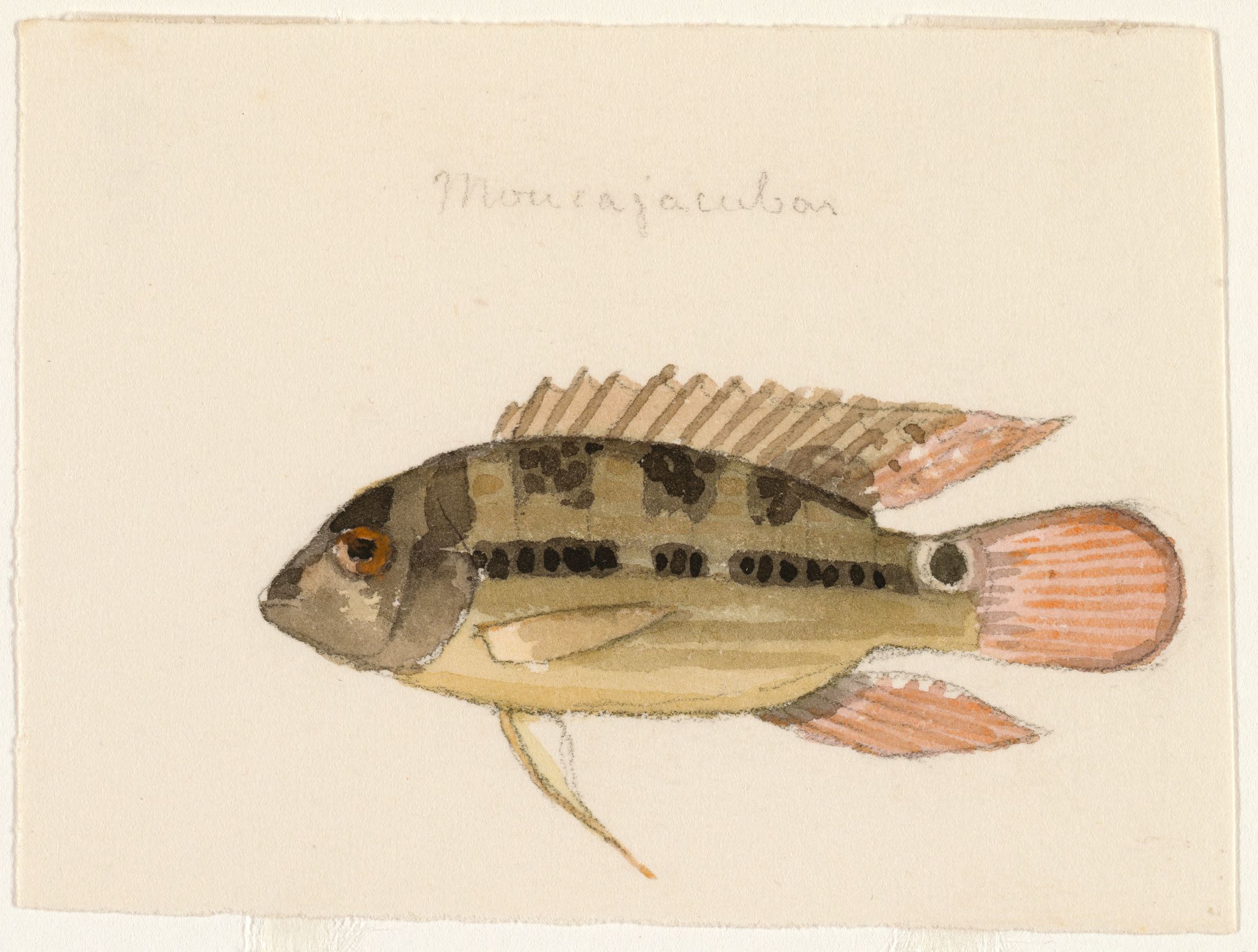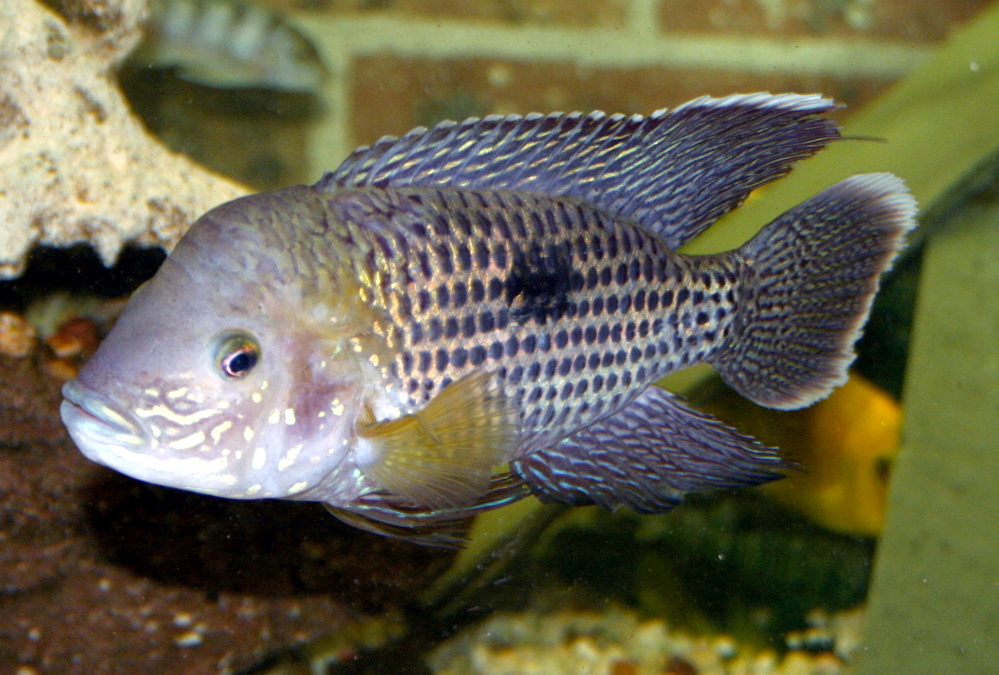|
Lugubria
''Lugubria'' is a South American cichlid genus in the tribe Geophagini. It was introduced by four South American ichthyologists and their Swedish colleague Sven O. Kullander, S. O. Kullander, and the name is a near-tautonym of the chosen type species. Previously, the species placed in ''Lugubria'' belonged to the genus ''Crenicichla'' and formed the ''Crenicichla lugubris'' species complex. The genus occurs throughout the Amazon Basin, in the catchment of the Orinoco and in the coastal rivers of the three Guyanas. Characteristics Like all pike cichlids, the ''Lugubria'' species have a pike-like, elongated body. They are relatively large pike cichlids and reach a standard length of . Their scales are relatively small, which means that a row of scales on the sides of the body consists of a very large number of scales. The number of soft rays in the dorsal and anal fins is also high (13 to 18 and 9 to 13 respectively). The number of vertebrae is high (39 to 44) and there are more t ... [...More Info...] [...Related Items...] OR: [Wikipedia] [Google] [Baidu] |
Lugubria Lugubris
The spottail pike cichlid (''Lugubria lugubris'') is a species A species () is often defined as the largest group of organisms in which any two individuals of the appropriate sexes or mating types can produce fertile offspring, typically by sexual reproduction. It is the basic unit of Taxonomy (biology), ... of pike cichlid native to South America. It is found in the Amazon River basin, in the Branco, Negro and Uatumã rivers in Brazil; the Essequibo River and Branco River in Guyana; the Corantijn River in Suriname. This species reaches a length of . References lugubris Fish of Bolivia Cichlid fish of Brazil Fish of Guyana Fish of Suriname Fish of the Amazon basin Fish described in 1840 Taxa named by Johann Jakob Heckel {{Cichlinae-stub ... [...More Info...] [...Related Items...] OR: [Wikipedia] [Google] [Baidu] |
Crenicichla Lenticulata
''Lugubria lenticulata'' is a species of cichlid Cichlids () are a large, diverse, and widespread family of percomorph fish in the family Cichlidae, order Cichliformes. At least 1,760 species have been scientifically described, making it one of the largest vertebrate families, with on ... native to South America. it is found in the Negro River basin of the Amazon River basin in Brazil. This species reaches a length of . References lenticulata Cichlid fish of Brazil Fish of the Amazon basin Fish described in 1840 Taxa named by Johann Jakob Heckel {{Cichlinae-stub ... [...More Info...] [...Related Items...] OR: [Wikipedia] [Google] [Baidu] |
Saxatilia
''Saxatilia'' is a South American cichlid genus in the genus group Geophagini. The genus was only erected in mid-2023 by four South American ichthyologists and their Swedish colleague Sven O. Kullander, and the name is a near-tautonym of the chosen type species. Previously, the species placed in ''Saxatilia'' belonged to the genus ''Crenicichla'' and formed the ''Crenicichla saxatilis'' species complex. Of all the genera of pike cichlids, ''Saxatilia'' has the widest distribution area. It occurs in the Amazon Basin, in the drainage basin of the Orinoco, in the entire river basin of the Río de la Plata, the Río Paraná and the Río Uruguay, in the coastal rivers of the Guyanas, on the islands of Trinidad and Tobago, in the coastal rivers of northeastern Brazil and in the lagoons Lagoa dos Patos and Lagoa Mirim in the south of Brazil. Characteristics Like all pike cichlids, the ''Saxatilia'' species have an elongated body. Males and females of the ''Saxatilia'' species Sexual di ... [...More Info...] [...Related Items...] OR: [Wikipedia] [Google] [Baidu] |
Geophagini
Geophagini is a Tribe (biology), tribe of cichlids from the subfamily Cichlinae, the American cichlids. It is the sister taxon to the clade which includes the Cichlasomatini and Heroini. Fishes in the Geophagini are distributed from Panama south to Argentina, it is the most speciose of the seven tribes within the Cichlinae and it is subdivided into three sub-tribes, Acarichthyina, Crenicaratina, and Geophagina which together contain over 200 species. Geophagines show morphological and behavioural specialisations to enable them to sift the substrates within their mouths so that they can separate benthic invertebrates from substrates dominated by sand or silt. Classification The Geophagini are classified as follows: * Subtribe Acarichthyina Sven O. Kullander, Kullander, 1998 ** Genus ''Acarichthys'' Carl H. Eigenmann, C. H. Eigenmann, 1912 ** Genus ''Guianacara'' Kullander & Han Nijssen, Nijssen, 1989 * Subtribe Crenicaratina Kullander, 1998 ** Genus ''Biotoecus'' C. H. Eigenmann & ... [...More Info...] [...Related Items...] OR: [Wikipedia] [Google] [Baidu] |
Crenicichla
''Crenicichla'' is a genus of cichlids native to South America commonly known as the pike cichlids. They are found in most tropical and subtropical freshwater habitats between the Andes and the Atlantic. Description The smallest species of ''Crenicichla'' are no larger than Gottwald, J: Crenicichla arten.' and may be referred to as " dwarf cichlids" for the aquarium hobby – though their aggressive and territorial habits make them unsuitable for novice keepers. The smallest members, and formerly the ''C. wallacii'' species complex was split off to '' Wallaciia'' in 2023, along with the former ''C. saxatilis'' complex which became '' Saxatilia'' and the ''C. lugubris'' complex which became '' Lugubria''. In the same paper, one further genus was erected ('' Hemeraia'') and the remaining species were divided into subgenera. The largest pike cichlids can grow to about long. Most ''Crenicichla'' measure in the range of . Like many other predatory fishes, a pike cichlid has a ... [...More Info...] [...Related Items...] OR: [Wikipedia] [Google] [Baidu] |
Hemeraia
''Hemeraia'' is a South American cichlid genus in the tribe Geophagini. The genus was only newly introduced in mid-2023 by four South American ichthyologists and their Swedish colleague S. O. Kullander. Previously, the species placed in ''Hemeraia'' belonged to the genus ''Crenicichla''. There are two species, one of which (''Hemeraia hemera'') occurs in the catchment area of the Rio Aripuanã and the other (''H. chicha'') in the catchment area of the Rio Juruena, a headwater of the Rio Tapajós. Characteristics Like all pike cichlids, the ''Hemeraia'' species have a pike-like, elongated body. The number of vertebrae is high and there are more trunk vertebrae than caudal vertebrae, or their number is equal, while in most other cichlid genera it is the other way around. ''Hemeraia'' species are medium-sized pike cichlids and reach a standard length of . Their pelvic fins are short and rounded. The second fin ray is the longest; however, it does not reach the genital papilla. O ... [...More Info...] [...Related Items...] OR: [Wikipedia] [Google] [Baidu] |
Cichlid Genera
Cichlids () are a large, diverse, and widespread family of percomorph fish in the family Cichlidae, order Cichliformes. At least 1,760 species have been scientifically described, making it one of the largest vertebrate families, with only the Cyprinidae being more speciose. New species are discovered annually, and many species remain undescribed. The actual number of species is therefore unknown, with estimates varying between 2,000 and 3,000. They are native to the Neotropics, Africa (including Madagascar), the Middle East, and the Indian subcontinent, although some species have been introduced worldwide. Many cichlids, particularly tilapia, are important food fishes, while others, such as the '' Cichla'' species, are valued game fish. The family also includes many popular freshwater aquarium fish kept by hobbyists, including the angelfish, oscars, and discus. Cichlids have the largest number of endangered species among vertebrate families, most in the haplochromi ... [...More Info...] [...Related Items...] OR: [Wikipedia] [Google] [Baidu] |
Cichlid Fish Of South America
This is a list of South American cichlid species that are commonly kept by aquarists. See also * List of African cichlids *Aquarium An aquarium (: aquariums or aquaria) is a vivarium of any size having at least one transparent side in which aquatic plants or animals are kept and displayed. fishkeeping, Fishkeepers use aquaria to keep fish, invertebrates, amphibians, aquati ... References {{DEFAULTSORT:Cichlid fish of South America List Lists of fishes ... [...More Info...] [...Related Items...] OR: [Wikipedia] [Google] [Baidu] |
Cycloid Scales
A fish scale is a small rigid plate that grows out of the skin of a fish. The skin of most jawed fishes is covered with these protective scales, which can also provide effective camouflage through the use of reflection and colouration, as well as possible hydrodynamic advantages. The term ''scale'' derives from the Old French , meaning a shell pod or husk. Scales vary enormously in size, shape, structure, and extent, ranging from strong and rigid armour plates in fishes such as shrimpfishes and boxfishes, to microscopic or absent in fishes such as eels and anglerfishes. The morphology (biology), morphology of a scale can be used to identify the species of fish it came from. Scales originated within the jawless ostracoderms, ancestors to all jawed fishes today. Most bony fishes are covered with the cycloid scales of salmon and carp, or the ctenoid scales of perch, or the ganoid scales of sturgeons and gars. Cartilaginous fishes (sharks and rays) are covered with placoid scales ... [...More Info...] [...Related Items...] OR: [Wikipedia] [Google] [Baidu] |
Wallaciia
''Wallaciia'' is a South American genus of cichlids from the tribe Geophagini. The genus was only erected in mid-2023 by four South American ichthyologists and their Swedish colleague Sven O. Kullander. It was named in honour of the British naturalist Alfred Russel Wallace, and is a near-tautonym of the chosen type species. Previously, the species placed in ''Wallaciia'' belonged to the genus ''Crenicichla'' and formed the ''Crenicichla wallacii'' species complex. The genus ''Wallaciia'' occurs in the Amazon Basin from the Rio Madeira to the Rio Tocantins, but is absent west of Santo Antônio do Içá or the mouth of the Río Putumayo into the Amazon. The genus is also found in the drainage basins of the Orinoco and the Essequibo. Description Like all pike cichlids, ''Wallaciia'' species have a pike-like, elongated body. The number of vertebrae is high and there are more trunk vertebrae than tail vertebrae, while in most other cichlid genera it is the other way round. ''Wal ... [...More Info...] [...Related Items...] OR: [Wikipedia] [Google] [Baidu] |
Teleocichla
''Teleocichla'' is a genus of fish in the family Cichlidae found in the Tapajós, Xingu, Tocantins and Jari River basins, which are part of the Amazon River Basin in Brazil. All species are rheophilic, and highly elongated in shape. They generally are smaller than in length, making them some of the smallest cichlids of the Americas. Only ''T. preta'' can grow larger, reaching about . Since restricted to areas with fast currents (such as cataracts and rapids), they are particularly vulnerable to the building of dams, and the Belo Monte Dam may cause the extinction of ''T. centisquama''. Other species recognized as threatened by Brazil's Ministry of the Environment are ''T. cinderella'', ''T. prionogenys'' and ''T. wajapi''. Species There are currently 9 recognized species in this genus, but several undescribed species are known. * '' Teleocichla centisquama'' Zuanon & I. Sázima ( fr), 2002 (slender pike cichlid) * '' Teleocichla centrarchus'' Kullander, 1988 * '' Teleocichl ... [...More Info...] [...Related Items...] OR: [Wikipedia] [Google] [Baidu] |
Humeral Spot
Humeral spot (from Latin ''humerus'', pertaining to the shoulder) is a mark or pattern found on several species of fish, typically above the pectoral fin. In insects, the humeral spot may be found on the Glossary_of_entomology_terms#Costa, costal area of the wing. References {{Animal-physiology-stub Humerus Fish physiology Insect physiology ... [...More Info...] [...Related Items...] OR: [Wikipedia] [Google] [Baidu] |



